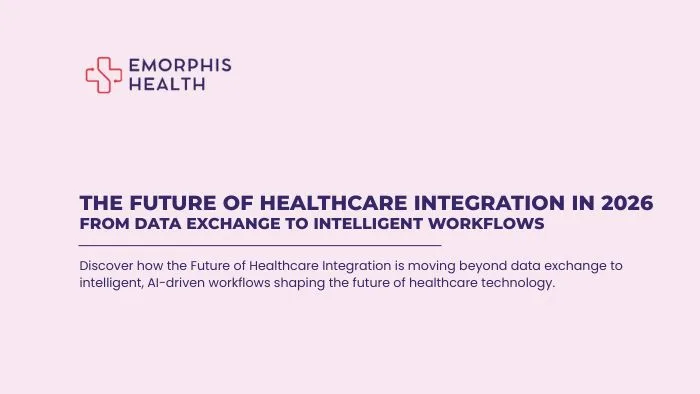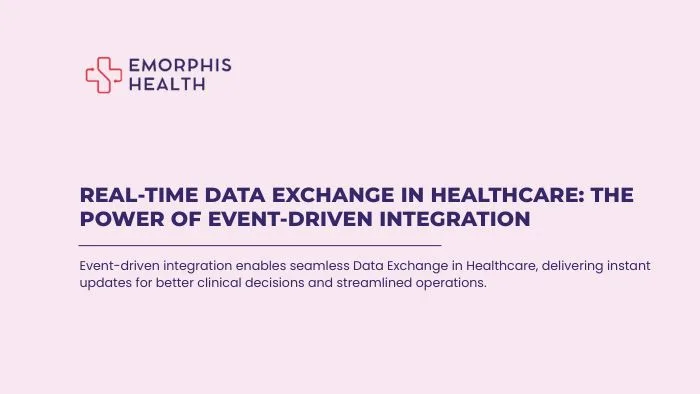The Shift in the Future of Healthcare Technology
See Contents
- 1 The Shift in the Future of Healthcare Technology
- 2 Why Traditional Integration Needs Reinvention
- 3 Emerging Trends in Healthcare Integration
- 4 1. From Data Exchange to Intelligent Workflows
- 5 2. Event-Driven Architecture in Modern Healthcare Systems
- 6 3. Microservices: Building Blocks for the Future of Healthcare Integration
- 7 4. The Rise of FHIR APIs and Open Standards
- 8 5. AI-Powered Analytics and Predictive Workflows in Healthcare Integration
- 9 6. Security and Compliance in the Future of Healthcare Integration
- 10 7. Integration Platforms of the Future: Low-Code, Cloud-Native, and AI-Augmented
- 11 Conclusion: A Smarter, Connected Future for Healthcare
The future of healthcare technology is moving toward a stage where integration is not only about transferring data but about creating intelligent interactions among systems. For decades, healthcare organizations have focused on interoperability as a technical challenge, primarily on connecting electronic health records and exchanging HL7 or FHIR data. However, the Future of Healthcare Integration in 2026 represents a deeper transformation. It focuses on building systems that communicate, interpret, and act intelligently to support clinical and operational decision-making.
Traditional integration was designed to move data between systems, but healthcare today operates in real time. Data arrives from connected devices, telehealth platforms, and multiple clinical systems. This data must trigger immediate responses, not just storage or delayed review. The Future of Healthcare Integration brings this responsiveness by combining automation, artificial intelligence, and event-driven design. Integration now means orchestrating workflows that respond automatically to clinical events and patient needs.
For example, suppose a patient’s wearable device detects irregular heart activity. In that case, it should not only record the data but also initiate an alert, schedule an assessment, and update the patient’s care plan. This kind of workflow represents the future of healthcare technology, where systems work together in context, powered by intelligent integration.
Technologies such as event-driven architecture, microservices, and FHIR APIs are shaping this evolution. They allow healthcare systems to adapt to new data instantly, without human intervention or manual coordination. As organizations move toward this model, the Future of Healthcare Integration will form the foundation for smarter, more efficient, and proactive care delivery. The coming years will show that integration is no longer about data transfer; it is about enabling intelligent, collaborative, and patient-centered workflows.
Why Traditional Integration Needs Reinvention
Traditional healthcare integration was built around the idea of data exchange. Systems connected through HL7 interfaces, point-to-point integrations, or middleware solutions that simply moved information from one system to another. While this model worked for basic interoperability, it no longer meets the needs of modern healthcare environments. The Future of Healthcare Integration is about dynamic, intelligent connectivity that supports real-time decisions and continuous care.
The future of healthcare technology demands more than static data movement. Healthcare data is now generated by numerous sources, such as IoT devices, mobile health apps, and remote patient monitoring systems. These sources produce large volumes of real-time information that legacy systems are not equipped to handle efficiently. The old integration methods are slow, costly to maintain, and lack adaptability to evolving standards like FHIR or cloud-based infrastructures.
To stay relevant in the Future of Healthcare Integration, healthcare organizations must overcome several limitations found in traditional models:
- Limited real-time capability: Legacy systems process data in batches, delaying critical clinical responses.
- Rigid architecture: Point-to-point interfaces make updates or system replacements complex and time-consuming.
- High maintenance costs: Each interface must be manually managed, increasing both time and operational expense.
- Lack of contextual awareness: Traditional systems only transfer data without understanding its clinical importance or urgency.
- Poor scalability: As new applications are added, integrations become harder to manage and synchronize.
In contrast, the future of healthcare technology focuses on creating an adaptive integration layer that allows systems to communicate intelligently. AI, event-driven workflows, and microservices provide the foundation for faster, more context-aware interactions. The Future of Healthcare Integration will therefore not rely on static interfaces but on flexible, scalable systems that can evolve with new healthcare demands and innovations.
Emerging Trends in Healthcare Integration
The healthcare integration landscape is evolving rapidly as digital transformation accelerates across hospitals, payers, and life sciences organizations. What was once a focus on simple data exchange is now shifting toward intelligent, context-aware systems that learn, adapt, and respond in real time. The future of healthcare interoperability will not only connect systems but also empower smarter workflows, faster decision-making, and safer care delivery.
Today’s integration trends reflect a fundamental shift from connecting data silos to creating a unified digital health ecosystem where insights flow seamlessly across the patient journey. Below are the leading trends shaping this transformation, each redefining how healthcare organizations integrate, automate, and innovate.
Key Trends Defining the Future of Healthcare Integration
- From Data Exchange to Intelligent Workflows
- The Role of Event-Driven Architecture in Modern Healthcare Systems
- Microservices: Building Blocks for the Future of Healthcare Integration
- The Rise of FHIR APIs and Open Standards
- AI-Powered Analytics and Predictive Workflows in Healthcare Integration
- Security and Compliance in the Future of Healthcare Integration
- Integration Platforms of the Future: Low-Code, Cloud-Native, and AI-Augmented
These are the emerging trends we will explore in detail next, uncovering how each one is driving greater agility, interoperability, and intelligence in healthcare integration.
1. From Data Exchange to Intelligent Workflows
The future of healthcare technology is evolving from simple data exchange toward the creation of intelligent workflows that improve how healthcare systems operate and deliver care. In the past, integration was mainly about transferring data between systems like EHRs, laboratory software, and billing platforms. These exchanges helped ensure information availability but did not automatically generate actions or insights. The Future of Healthcare Integration changes this model entirely by turning every piece of data into a trigger for meaningful workflow automation.
In this new era, integration means that systems can interpret, respond, and adapt to data in real time. When a patient’s lab result indicates a potential issue, the system should not only store the result but also alert the care team, suggest follow-up tests, and update the patient’s health record. This creates a connected, context-aware ecosystem that continuously learns and reacts to patient needs. Such intelligent workflows define the Future of Healthcare Integration, where integration becomes the foundation of proactive healthcare rather than reactive processes.
Key features that define this evolution include:
- Automation of routine tasks: Systems automatically schedule appointments, send reminders, and generate reports without manual intervention.
- Context-aware decision support: Data is interpreted based on patient history and clinical context, helping clinicians make faster and better decisions.
- AI-driven orchestration: Machine learning models identify trends and automate responses across multiple systems.
- Continuous collaboration: Integrated workflows connect departments, clinicians, and patients through unified communication channels.
These changes illustrate how the future of healthcare technology focuses on smart coordination instead of static information sharing. The Future of Healthcare Integration enables organizations to build workflows that not only move data but also act upon it in meaningful ways. This evolution supports faster care delivery, improved accuracy, and a more connected healthcare experience for both patients and providers.
2. Event-Driven Architecture in Modern Healthcare Systems
Event-driven architecture (EDA) is becoming a cornerstone of the Future of Healthcare Integration. In traditional systems, data exchange followed a linear pattern where one system sent information and another received it. This method works for basic interoperability but cannot meet the growing need for real-time responsiveness. The future of healthcare technology requires systems that can act instantly when a change or event occurs in a patient’s condition, clinical workflow, or hospital operation.
An event-driven approach allows healthcare systems to respond dynamically to new information. Instead of waiting for scheduled data transfers, systems can detect and react to events as they happen, such as a new lab result, a vital sign alert, or an updated prescription. Each event becomes a signal that triggers specific actions across connected systems. This responsiveness is what makes event-driven architecture an essential component of the Future of Healthcare Integration.
For example, when a wearable device reports abnormal oxygen levels, the event can:
- Notify the patient’s clinician immediately.
- Create a task in the hospital’s care management system.
- Update the patient’s EHR in real time.
- Alert an AI model to analyze potential causes and suggest next steps.
This continuous flow of events creates a system that thinks and reacts, improving the speed and quality of healthcare delivery.
Key advantages of adopting event-driven design in the future of healthcare technology include:
- Real-time response: Clinical actions can be taken as soon as an event occurs.
- Improved scalability: Systems can handle multiple event sources without delays.
- Reduced coupling: Each service operates independently, making maintenance and updates easier.
- Faster decision-making: Real-time analytics can be embedded into event workflows.
As more organizations move toward real-time healthcare operations, event-driven architecture will define how the Future of Healthcare Integration operates. It shifts the focus from exchanging data to responding intelligently, ensuring care delivery is both immediate and adaptive.


3. Microservices: Building Blocks for the Future of Healthcare Integration
Microservices architecture is transforming how healthcare systems are designed, deployed, and integrated. In the future of healthcare technology, monolithic systems that handle all operations under one large application are being replaced by smaller, independent services that perform specific tasks. This shift aligns directly with the Future of Healthcare Integration, where flexibility, scalability, and agility are essential to support evolving healthcare needs.
In a microservices-based environment, every function—such as patient registration, billing, scheduling, or analytics, is developed and deployed as an independent service. Each service communicates through APIs, allowing updates or new features without affecting the entire system. This modular approach helps healthcare organizations innovate faster, reduce downtime, and easily adapt to new compliance standards or interoperability requirements.
Microservices bring several advantages that support the Future of Healthcare Integration:
- Scalability: Each service can scale individually based on workload. For example, a patient monitoring module can scale during high admission periods without affecting billing or reporting functions.
- Faster innovation: Developers can update or deploy specific services without reconfiguring the entire system.
- Resilience: If one microservice fails, others continue functioning, improving system reliability.
- Simplified maintenance: Smaller, focused services are easier to debug and enhance.
- Integration flexibility: Microservices communicate through APIs, which aligns with standards like FHIR and supports seamless integration across different systems.
In practice, this means hospitals and digital health providers can integrate new modules, such as AI-driven diagnostic engines or telehealth services, without disrupting existing systems. The future of healthcare technology depends on this level of adaptability to handle new data types, third-party apps, and emerging digital workflows.
The Future of Healthcare Integration will rely on microservices as its structural foundation. They enable interoperability that is not just technical but strategic—supporting faster deployment of healthcare innovations, enabling personalized care models, and creating systems that grow and evolve with organizational needs.
4. The Rise of FHIR APIs and Open Standards
As the Future of Healthcare Integration advances, interoperability is being redefined through modern data exchange frameworks. At the heart of this shift is FHIR (Fast Healthcare Interoperability Resources), a standard designed to make healthcare data sharing faster, simpler, and more secure. In 2026, FHIR APIs are expected to become the default foundation for all healthcare systems that aim to connect seamlessly with payers, providers, and digital health applications.
Unlike earlier standards that relied on rigid file transfers, FHIR APIs enable real-time data access across systems while maintaining full compliance with healthcare regulations such as HIPAA and HL7. This new approach allows healthcare organizations to exchange structured and meaningful information effortlessly — from patient demographics to lab results and care plans.
FHIR is also accelerating the future of healthcare technology by supporting app-based ecosystems where EHR vendors, startups, and healthcare providers can build interoperable solutions without massive reengineering. This creates a plug-and-play integration model that promotes scalability and innovation.
Key benefits of FHIR APIs and open standards include:
- Improved interoperability: Enables data flow between diverse systems and care settings.
- Faster integrations: Reduces time and complexity in connecting new healthcare applications.
- Enhanced patient access: Empowers individuals to control and share their health data easily.
- Regulatory alignment: Meets global interoperability standards set by HL7 and ONC.
- Innovation enablement: Supports AI-driven analytics and mobile health applications.
The adoption of open standards like FHIR ensures that the Future of Healthcare Integration is not just about moving data, but about creating intelligent ecosystems where context, compliance, and collaboration work together. This evolution is a key pillar of the future of healthcare technology, driving transparency and trust across connected healthcare networks.
5. AI-Powered Analytics and Predictive Workflows in Healthcare Integration
As the future of healthcare technology evolves, AI is transforming the foundation of Future of Healthcare Integration. Integration platforms are no longer limited to exchanging patient data. Instead, they are becoming intelligent systems capable of understanding clinical context, predicting outcomes, and guiding decisions in real time.
In 2026, healthcare systems are expected to rely heavily on AI-powered analytics that continuously learn from connected EHRs, wearable devices, and IoMT (Internet of Medical Things) sensors. These integrations enable predictive workflows that help clinicians act before a crisis occurs.
For example, integrated AI can identify patterns of patient deterioration, medication non-adherence, or anomalies in vital data across distributed systems and trigger proactive alerts. This kind of predictive intelligence marks a major shift from reactive care to preventive and personalized care.
Key advantages of AI-powered predictive integration include:
- Early intervention: Predict potential complications and recommend timely responses.
- Automated data insights: Reduce manual data interpretation by generating clinical summaries automatically.
- Cross-system learning: Enable continuous improvement by analyzing data across hospitals, labs, and home devices.
- Contextual workflow automation: Use AI to suggest next actions within clinical applications.
The Future of Healthcare Integration will depend on how effectively AI can be embedded within interoperable systems to provide context-aware support. As hospitals modernize their infrastructure, the synergy between AI analytics and integration frameworks will become central to the future of healthcare technology, driving smarter, safer, and more connected patient care.


6. Security and Compliance in the Future of Healthcare Integration
As the Future of Healthcare Integration becomes more interconnected and intelligent, the importance of data security and regulatory compliance continues to grow. With the expansion of APIs, cloud-based applications, and AI-driven workflows, healthcare organizations face new challenges in safeguarding sensitive patient data while maintaining seamless interoperability.
In the future of healthcare technology, security is no longer just about encryption or access control. It’s about creating a trust framework across every connected system, ensuring that data remains protected throughout its lifecycle, from collection and transmission to storage and analysis. Modern integration platforms now embed compliance features natively, helping healthcare providers adhere to evolving regulations such as HIPAA, GDPR, and regional data protection laws.
Key aspects shaping secure healthcare integration include:
- Zero-trust architecture: Validates every connection, device, and user before granting access.
- End-to-end encryption: Ensures protected data exchange across FHIR APIs and cloud systems.
- Automated compliance monitoring: Tracks and reports integration activities in real time.
- Role-based access controls: Prevents unauthorized use of clinical or operational data.
- AI-driven threat detection: Identifies anomalies and potential breaches early.
The Future of Healthcare Integration depends on maintaining this balance between openness and protection. As organizations continue adopting advanced digital ecosystems, compliance will shift from a checklist to a continuous, technology-enabled process. In this landscape, secure data exchange becomes the foundation for innovation and patient trust — the ultimate goal of the future of healthcare technology.
7. Integration Platforms of the Future: Low-Code, Cloud-Native, and AI-Augmented
The next stage in the Future of Healthcare Integration will be driven by intelligent, adaptable platforms that simplify complex data orchestration. As healthcare systems handle growing data volumes and new interoperability standards, traditional middleware is giving way to low-code, cloud-native, and AI-augmented integration platforms that prioritize scalability, agility, and ease of use.
Low-code tools are empowering healthcare IT teams to design and deploy integrations without deep programming expertise. This democratization of development accelerates deployment cycles while reducing technical debt. At the same time, cloud-native architectures ensure that integrations can scale dynamically to meet varying data workloads, supporting high availability and performance across distributed care networks.
AI augmentation adds a new dimension to the future of healthcare technology by automating mapping, anomaly detection, and workflow optimization. Integration platforms can now self-learn from data patterns, recommend configuration changes, and predict potential bottlenecks before they occur.
Core features defining next-generation integration platforms:
- Drag-and-drop workflow builders for faster solution design.
- Serverless scalability to handle variable healthcare data loads.
- Embedded AI assistants for intelligent process automation.
- Cross-cloud interoperability to connect diverse systems securely.
- Continuous performance monitoring for proactive issue resolution.
In the Future of Healthcare Integration, these platforms will act as intelligent backbones connecting EHRs, wearables, lab systems, and AI tools into one cohesive ecosystem. They represent the future of healthcare technology, systems that are adaptive, learning, and capable of driving clinical excellence through seamless, intelligent integration.
Conclusion: A Smarter, Connected Future for Healthcare
The Future of Healthcare Integration is no longer defined by data movement alone. It represents a transformation where interoperability, intelligence, and automation work together to improve care quality and operational efficiency. From FHIR APIs and event-driven architectures to low-code platforms and AI-powered analytics, every layer of the healthcare ecosystem is evolving toward greater context awareness and real-time responsiveness.
As the future of healthcare technology unfolds, integration will play the most critical role in connecting systems, clinicians, and patients. Intelligent workflows will replace static data pipelines, allowing healthcare organizations to act on insights instantly rather than react to outcomes later. Security and compliance will continue to serve as the foundation of this evolution, ensuring that trust remains central in every digital interaction.
The next era of healthcare will belong to those who view integration not as a backend task but as a strategic enabler of innovation. By embracing modern architectures, open standards, and AI-driven automation, providers can move closer to a unified, intelligent, and patient-centered ecosystem.
In 2026 and beyond, the Future of Healthcare Integration will define how efficiently data transforms into decisions, marking a significant leap toward a connected, predictive, and intelligent healthcare system that truly embodies the promise of the future of healthcare technology.







